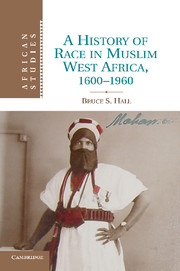Book contents
- Frontmatter
- Contents
- List of maps and figures
- Acknowledgments
- Note on orthography
- Abbreviations used in references
- Glossary
- Introduction
- PART ONE Race Along The Desert Edge, C. 1600–1900
- 1 Making Race in the Sahel, c. 1600–1900
- 2 Reading the Blackness of the Sudan, c. 1600–1900
- PART TWO Race And The Colonial Encounter, C. 1830–1936
- PART THREE The Morality of Descent, C. 1893–1940
- PART FOUR Race and Decolonization, C. 1940–1960
- Conclusion
- Index
- Misc-endmatter
- References
1 - Making Race in the Sahel, c. 1600–1900
Published online by Cambridge University Press: 05 August 2011
- Frontmatter
- Contents
- List of maps and figures
- Acknowledgments
- Note on orthography
- Abbreviations used in references
- Glossary
- Introduction
- PART ONE Race Along The Desert Edge, C. 1600–1900
- 1 Making Race in the Sahel, c. 1600–1900
- 2 Reading the Blackness of the Sudan, c. 1600–1900
- PART TWO Race And The Colonial Encounter, C. 1830–1936
- PART THREE The Morality of Descent, C. 1893–1940
- PART FOUR Race and Decolonization, C. 1940–1960
- Conclusion
- Index
- Misc-endmatter
- References
Summary
IBN BATTUTA IN THE NIGER BEND
When the medieval Moroccan traveler Ibn Baṭṭūṭa (d. 1368) visited the West African Sahel in 1352 and 1353, he brought with him a North African conception of racial difference that appears to have been unfamiliar to the people with whom he interacted. In the written narrative of his travels, Ibn Battuta repeatedly distinguished between three principal types of people found in the area: Berbers, blacks, and whites. It is clear that those he identified as whites included only people like himself: Arab expatriates from North Africa or the Middle East who resided in the commercial towns along the Sahel, most of whom were merchants. With one exception, color terminology was not used to identify or describe the Berber-speaking peoples from the Sahel who are mentioned in his narrative, such as the Massūfa of Walata and Timbuktu or the Bardāma and Hakkār of the southern and central Sahara. For Ibn Battuta, the use of the term “whites” implied a set of Arab Muslim cultural practices that his local Berber-speaking hosts, although Muslims, did not share. He was so scandalized by the freedom Massūfa Berber women appeared to enjoy in their social interactions with men, and by their matrilineal system of descent, that he compared local Berber speakers to non-Muslims he had encountered in South Asia.
The use of color terminology in marking human difference was not uncommon in medieval North Africa and the Middle East.
- Type
- Chapter
- Information
- A History of Race in Muslim West Africa, 1600–1960 , pp. 34 - 68Publisher: Cambridge University PressPrint publication year: 2011

